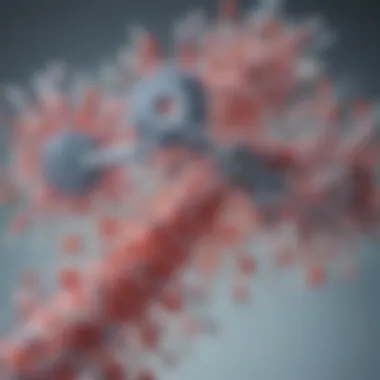The Significance of mRNA Vaccines in Health


Intro
The advent of mRNA vaccines marks a significant leap forward in the field of immunology. In recent years, these vaccines have captured the public's attention, especially given their pivotal role in the global response to the COVID-19 pandemic. But delving deeper into the science behind these vaccines reveals a rich tapestry of technological innovation and rigorous research. This guide aims to break down the complexities of mRNA vaccines, elucidating their mechanisms, benefits, and broader implications for public health.
Overview of Research Topic
Brief Background and Context
Traditionally, vaccines have relied on weakened or inactivated forms of a pathogen to stimulate an immune response. However, mRNA vaccines catapult us into a new era. Instead of using an entire virus, they use a small piece of genetic material from the virus itself. The mRNA, or messenger RNA, instructs the body’s own cells to produce a harmless protein that resembles a part of the virus. This prompts the immune system to recognize and fight against future infections.
The first major applications of mRNA technology were seen with the development of COVID-19 vaccines like Pfizer-BioNTech and Moderna. These rapid developments underscore not only the urgency brought about by the pandemic, but also the readiness of scientific communities to adapt and innovate.
Importance in Current Scientific Landscape
In today's scientific landscape, the significance of mRNA vaccines extends beyond immediate disease prevention. They serve as a pioneering model for future vaccine development against various infectious diseases, such as influenza and Zika. Furthermore, this platform has the potential for adaptations in cancer treatments, allowing for personalized medicine approaches that can tailor vaccines to individual patients’ tumors.
The implications of this technology stretch into public health policymaking, where it offers new avenues for vaccine manufacturing and distribution, potentially improving access in underserved regions.
"mRNA technology is not just a tool for today’s problems but a framework for solving future health challenges."
Methodology
Research Design and Approach
A comprehensive understanding of mRNA vaccines can emerge from a multi-disciplinary approach. This involves combining insights from fields like molecular biology, immunology, and public health. Studies investigating the efficacy, safety, and public acceptance of mRNA vaccines provide valuable data that informs best practices in vaccination efforts.
Data Collection Techniques
Data collection on mRNA vaccines can arise from various methods:
- Clinical Trials: These are essential for proving the safety and effectiveness of vaccines before they can be authorized for public use.
- Epidemiological Studies: These investigate the real-world effectiveness of vaccines in broader populations, exploring outcomes like infection rates and community immunity.
- Surveys and Interviews: Engaging with healthcare professionals and the general public can reveal attitudes toward vaccination, helping to shape educational interventions.
Ultimately, understanding mRNA vaccines necessitates a blend of theoretical knowledge and practical experience drawn from ongoing research and real-world applications.
Prologue to mRNA Technology
mRNA technology marks a watershed moment in the field of immunology. This section intends to delve into its importance in today’s health landscape, specifically within the context of vaccine development. It’s not just a science project; this innovation has the potential to reshape how we approach disease prevention, infectious outbreaks, and even chronic conditions.
One of the key advantages of mRNA vaccines is their ability to be rapidly developed in response to emerging pathogens. Unlike traditional vaccines, which often rely on weakened or inactivated forms of a virus, mRNA vaccines can be designed swiftly by leveraging genetic information. This allows health organizations to respond to threats faster than what was previously thought possible—a critical factor in the race against diseases like COVID-19.
Moreover, mRNA technology offers a more robust safety profile. By utilizing messenger RNA to instruct cells to produce specific proteins, it mimics the natural processes of the body without introducing live pathogens. This fundamentally alters the equation, reducing the risk of adverse effects commonly associated with other vaccine types.
In addition to these benefits, the technology has opened doors for fascinating applications beyond infectious diseases. Researchers are exploring its use in treating cancer and autoimmune disorders, suggesting a broader impact on global health strategies.
This section sets the stage to explore how historical developments shaped mRNA technology and what exactly mRNA entails in the next subsections.
Historical Context
To truly appreciate the significance of mRNA technology, one must consider its evolution over the decades. The roots of messenger RNA research date back to the early 1960s, during a time when molecular biology was just beginning to blossom. Scientists like Sydney Brenner and François Jacob pioneered work on the central dogma of molecular biology, establishing the foundational principles of how genetic information is translated into biological functions.
Fast forward to the 1990s, the potential application of mRNA for therapeutic use began to surface. Early studies utilized mRNA to induce proteins that could trigger immune responses, yet this concept faced hurdles, particularly in delivery mechanisms and stability of the mRNA in vivo.
The landscape shifted dramatically in the 2010s with advances in nanoparticle delivery systems and lipid formulations, which safeguarded the fragile mRNA molecules during transport within the body. The groundbreaking trials and eventual emergency use of mRNA vaccines during the COVID-19 pandemic served as a testament to the culmination of decades of research, proving the effectiveness of mRNA technology when put to the test.
What is mRNA?
Messenger RNA, or mRNA, is simply a type of RNA that serves as a temporary blueprint for protein synthesis in cells. While many might think of DNA as the master script of life, mRNA plays a crucial intermediary role. It carries genetic information from DNA to the ribosome, where proteins are made.
In the world of mRNA vaccines, this messenger RNA does something rather striking: it instructs our cells to produce a harmless piece of the target virus, prompting an immune response. This immune memory is vital—it’s like training a soldier in advance to recognize a foe. The immune system learns to identify and combat the actual virus if it encounters it later on.
Some salient points about mRNA include:
- Single-Stranded: Unlike DNA, mRNA is single-stranded, allowing greater flexibility in its role within the cell.
- Transient Nature: mRNA does its job and quickly degrades. This is important as it prevents prolonged expression of the viral protein, limiting any potential risks.
- Customization Potential: Scientists can rapidly design mRNA to target various pathogens, from viruses to cancer cells, opening a world of possibilities for future treatments.
"The use of mRNA technology represents a shift in how we think about vaccine development and immune response, encapsulating years of fundamental research into practical applications."
Overall, understanding mRNA sets the groundwork for appreciating the innovative leaps in vaccine technology and opens avenues for discussions about its broader impact in the following sections.


Mechanism of Action of mRNA Vaccines
The mechanism of action of mRNA vaccines is a fundamental aspect that underpins their revolutionary approach to immunization. Understanding how these vaccines work is critical not only for grasping their significance in public health but also for appreciating the science behind vaccine development. The essential function of mRNA vaccines is to encode a piece of the pathogen's genetic material, typically a virus, prompting the immune system to recognize and prepare against it without exposing the body to the actual disease.
Delivery of mRNA into Cells
The delivery of mRNA into cells is a crucial step in this process. When an mRNA vaccine is administered, the mRNA is encapsulated in lipid nanoparticles, which serve as tiny delivery vehicles. These nanoparticles facilitate the transport of mRNA through the extracellular environment and into cells. In a way, one could liken these particles to a Trojan horse, carrying the valuable genetic information right into the heart of immune cells.
Once injected, the lipid nanoparticles merge with the cell membranes, releasing the mRNA into the cytoplasm. Here lies the magic; cells interpret this mRNA as a blueprint for protein synthesis. Importantly, this method sidesteps the need for live pathogens to trigger an immune response, which works favorably for safety. Additionally, this delivery mechanism ensures that the mRNA is efficiently transported, maximizing the potential for robust immune activation.
"The brilliance of mRNA vaccines lies in their ability to train the immune system to recognize and combat pathogens without using live viruses, fundamentally changing our approach to vaccination."
Protein Synthesis and Immune Response
Following successful delivery, mRNA translation occurs, resulting in the synthesis of viral proteins. These proteins are broken down into small pieces called peptides, which are then displayed on the cell's surface. This showcasing acts as a red flag for the immune system, signaling that these foreign pieces do not belong. The immune response kicks into gear, as both B cells and T cells are activated.
Specifically, B cells produce antibodies targeting the viral proteins, while T cells destroy infected cells. Over time, this response cultivates memory cells that remain vigilant to the pathogen. Should the body encounter the actual virus in the future, these memory cells can quickly mobilize an immune response, effectively preventing severe illness.
Overall, the mechanism of action in mRNA vaccines represents a sophisticated interplay between molecular biology and immunology. It exemplifies a shift in how we conceive of vaccines, where speed, efficiency, and safety are elevated. Understanding this mechanism helps clarify why mRNA vaccines are not just a passing trend; rather, they represent a new frontier in vaccine technology with promising future applications.
Comparative Analysis with Traditional Vaccines
The shift from traditional vaccine methodologies to mRNA technology has sparked significant discussions in both scientific and public domains. Understanding these disparities matters, as each approach provides unique benefits and challenges in managing public health crises. In this section, we will delve into the fundamental differences in composition and function and explore the efficacy and speed of development of mRNA vaccines compared to traditional options, spotlighting why this analysis is pivotal for future vaccine approaches.
Differences in Composition and Function
Traditional vaccines largely fall into two camps: live-attenuated and inactivated. Live-attenuated vaccines use weakened forms of the virus, enabling a natural immune response to develop. In contrast, inactivated vaccines contain virus cells that are killed or inactive, compelling the immune system to respond without the risk of disease.
mRNA vaccines, however, take an entirely different route. Instead of introducing virus particles, they deliver genetic instructions directly to cells. This process begins when the vaccine injects synthetic messenger RNA, which carries the blueprint for producing a harmless piece of the virus—specifically, the spike protein seen in pathogens like SARS-CoV-2. The body's own cells then turn this genetic material into proteins that mimic the virus, allowing the immune system to recognize and combat the threat.
The implications here are profound. The composition of mRNA vaccines avoids the complexities tied to live viruses. They can't cause disease and don't require extensive handling procedures to ensure pathogen safety, making them simpler and potentially safer.
- Traditional Vaccines:
- mRNA Vaccines:
- Live-attenuated or inactivated viral strains.
- May cause mild symptoms.
- Require lengthy incubation periods.
- Genetic material encoding viral proteins.
- Inability to cause the disease.
- Quick and straightforward manufacturing.
Efficacy and Speed of Development
The timescale required to develop and distribute a vaccine is crucial, especially when faced with emerging infectious diseases. Traditional methods often mean years or even decades of research and development. This is not only time-consuming but also costly.
mRNA vaccine technology drastically reduces this timeline. The ease of synthesizing mRNA allows for rapid design adjustments in response to shifting viral mutations. For instance, once scientists identified SARS-CoV-2, they quickly produced mRNA vaccines like the ones from Pfizer and Moderna.
- Speed to Market:
- Traditional vaccines may take 10+ years.
- mRNA vaccines can be developed in a matter of months.
Furthermore, clinical trials for mRNA vaccines have shown high efficacy rates. The studies for the COVID-19 vaccines demonstrated efficacy rates of around 95%. These impressive numbers often exceed those of traditional vaccines.
"The speed and efficiency of mRNA technology represent a new frontier in vaccine development, shifting paradigms in how we approach infectious diseases."
As traditional vaccines face challenges with mutations and variants, mRNA's adaptability presents a particular advantage. The ability to update the vaccine’s composition as new threats arise illustrates its unique capabilities. In making these comparisons, it becomes clearer why mRNA technology holds the future of vaccination, with its potential to evolve alongside pathogens, keeping public health measures a step ahead.
This evaluation reveals that while traditional vaccines have reliably been a cornerstone of public health, mRNA vaccines have introduced a versatile and efficient alternative. Understanding these differences is essential for students and professionals alike, as it informs critical decision-making in vaccine policy and public health strategies.
Advantages of mRNA Vaccines
The introduction of mRNA vaccines marks a significant shift in how we approach vaccination and disease prevention. Unlike traditional vaccines that often use weakened or inactivated pathogens, mRNA vaccines utilize a novel method that brings a host of advantages. Understanding these benefits is crucial not only for students and professionals in the medical field but also for the general public navigating through the complexities of vaccine technology today.
Rapid Production and Scalability
One of the standout features of mRNA vaccines is their rapid production capability. When a novel pathogen emerges, time is of the essence. Traditional vaccine development can span years, often involving cumbersome processes of virus cultivation or isolation. In contrast, mRNA technology allows scientists to design a vaccine within weeks. For instance, once the genetic sequence of the SARS-CoV-2 virus was shared publicly in early 2020, researchers at companies like Moderna swiftly developed a candidate vaccine in record time.
This swiftness hinges on the ability to use synthetic processes. By sending the genetic instructions directly into cells—to instruct them to produce the desired viral proteins—the need for live pathogens is bypassed. Consequently, this method doesn't just speed up the initial phases of vaccine development. It also allows for scalability; mass production can be ramped up quickly, enabling countries to meet the demands of their populations in urgent circumstances.
- Efficiency in design and synthesis reduces lead times significantly.
- The adaptability of mRNA technology enables quick updates for variants.
Such efficiencies mean that we can potentially react faster to outbreaks, changing the landscape of public health response.


Safety Profile and Reduced Risk of Infection
The safety profile of mRNA vaccines is another noteworthy advantage. Since these vaccines do not employ live viruses, the risk of causing disease from the vaccine itself is significantly lowered. Instead, mRNA vaccines stimulate an immune response by instructing cells to produce a harmless piece of the target virus, such as the spike protein of the coronavirus.
With fewer ingredients involved compared to traditional vaccines, there is a lower likelihood of adverse side effects. Moreover, the mRNA does not remain in the body long-term; it is quickly broken down and eliminated.
Studies have shown that mRNA vaccines have significantly reduced the rates of severe disease and hospitalization associated with COVID-19. The efficacy speaks volumes:
- High effectiveness in preventing symptomatic COVID-19.
- Substantial reduction in hospitalizations and deaths due to the virus.
"Vaccination with mRNA technology is like giving a blueprint to the immune system; it can learn to recognize enemies without ever encountering the threat itself."
These vaccines not only confer protection to the vaccinated individual but also contribute to broader community health. By reducing the risk of transmission, they help pave the way towards herd immunity, which is vital for curbing outbreaks in the future. Overall, the advantages of mRNA vaccines reshape our understanding of immunization and leave a promising mark on global health strategies.
Case Study: mRNA Vaccines in the COVID-19 Pandemic
The emergence of mRNA vaccine technology has been a game-changer in our approach to combating infectious diseases, most notably highlighted during the COVID-19 pandemic. This chapter underscores the intricate role these vaccines played in addressing an unprecedented global health crisis. Understanding this case study is essential, as it showcases the practical application of mRNA technology, the efficacy of these vaccines in real-world settings, and the broader implications for public health.
Real-World Application and Outcomes
When COVID-19 first surfaced, the global medical community was in a race against time. Traditional vaccine platforms often require years to develop, but with mRNA technology, scientists had a new toolkit at their disposal. The Pfizer-BioNTech and Moderna vaccines were among the first to gain emergency use authorization. These vaccines employed messenger RNA to instruct cells to produce a harmless piece of the virus's spike protein, prompting the immune system to recognize and fight the actual virus if exposed.
The response was nothing short of remarkable:
- Rapid Development: Within a few months, these vaccines were engineered and tested on thousands of volunteers.
- Efficacy Rates: Clinical trials reported efficacy rates of over 90%, a phenomenal achievement given the short timeframe of development.
- Real-World Data: After rollout to the public, studies showed that these vaccines significantly lowered hospitalizations and deaths compared to unvaccinated individuals.
The sheer speed and effectiveness demonstrated by mRNA vaccines created a paradigm shift, not only in vaccine technology but also in public health strategies. This advancement can be linked to both the flexibility of mRNA technology and the robust infrastructure already in place for vaccine distribution.
Lessons Learned
The COVID-19 pandemic has served as a potent teacher in numerous ways, particularly regarding mRNA vaccines. Several critical lessons have emerged from this global health event:
- Importance of Speed and Agility: The swift approval and deployment of mRNA vaccines highlighted the need for adaptable research methodologies in pandemics.
- Public Trust in Science: Maintaining public trust became pivotal. Efforts to transparently communicate the science and safety of mRNA vaccines were crucial in countering hesitancy and misinformation.
- Global Collaboration: The collaborative efforts between nations, pharmaceutical companies, and researchers were unprecedented. This cooperation underscored the importance of global solidarity in addressing health crises.
- Future Applications: The success of mRNA vaccines against COVID-19 has led to interest in developing vaccines for other infectious diseases and even cancer therapies.
Despite the challenges faced throughout the pandemic, the adaptability and effectiveness of mRNA vaccines have planted seeds for future innovations, proving this technology's resilience in the face of a health emergency.
"The speed at which mRNA vaccines were developed exemplifies the synergy between technology and science in addressing global health crises."
Regulatory and Ethical Considerations
The regulatory and ethical considerations surrounding mRNA vaccines are crucial to understanding their integration into public health strategies. Gaining insight into this landscape helps illuminate how these groundbreaking vaccines can be safely and effectively deployed in combating diseases. Regulatory bodies like the FDA and EMA have stringent processes to ensure that any vaccine, including mRNA vaccines, meets high safety and efficacy standards before it reaches the general population.
Approval Process for mRNA Vaccines
The approval process for mRNA vaccines is a meticulous journey that involves multiple phases of clinical trials. These phases are designed to assess various aspects of the vaccine such as safety, dosage, and the immune response it provokes.
- Preclinical Testing: Before human trials, researchers conduct lab tests and trials on animals. This stage gathers initial data on safety and biological activity.
- Phase 1 Trials: Small groups of volunteers receive the vaccine to test safety and dosage.
- Phase 2 Trials: Expanded testing with hundreds of participants assesses the vaccine's efficacy and further evaluates safety.
- Phase 3 Trials: Thousands take part in these trials to compare the vaccine's effectiveness against a placebo, providing robust data on protection levels in diverse populations.
- Regulatory Review: Once the trials yield favorable data, companies submit their results to regulatory agencies for review. The agencies scrutinize the evidence for safety and efficacy rigorously.
- Post-Market Surveillance: Even after approval, continuous monitoring is critical to quickly identify any rare side effects or unexpected outcomes as the vaccine is rolled out to a broader audience.
This entire process is vital. It allows for a high degree of confidence in the mRNA vaccines’ ability to provide protection, ensuring public trust and safer immunization practices.
Ethical Dilemmas in Vaccine Distribution
As mRNA vaccines become increasingly available, ethical considerations surrounding their distribution and accessibility come to the forefront. Distribution is not just about getting vaccines to market but also involves ensuring equity among populations with differing needs and resources.
Some key ethical dilemmas include:
- Equitable Access: Ensuring that vaccines are available not just in wealthy nations but also in low-income regions poses a major challenge. The disparity in access can lead to unequal immunization rates and, subsequently, failure to achieve herd immunity.
- Informed Consent: Individuals must be provided with clear, comprehensible information about the vaccine’s risks and benefits. Misinformation can lead to hesitancy among populations that might benefit.
- Prioritization of Groups: Who gets vaccinated first — healthcare workers, those at risk, or the general population? Balancing these interests requires careful ethical reasoning and public engagement.
The delivery of vaccines is not merely a logistics problem; it’s an ethical one, influencing the very fabric of social trust we rely upon in public health initiatives.
Addressing these challenges is crucial for maintaining public confidence in health systems and ensuring that the full potential of mRNA vaccines is realized. By focusing on transparency and fairness, mRNA vaccines can truly become a cornerstone of global health initiatives.
Future Prospects of mRNA Vaccine Technology
The field of mRNA vaccine technology is on the precipice of incredible possibilities. As we’ve seen substantial progress during the COVID-19 pandemic, it has become clear that this approach has potential that stretches far beyond just infectious diseases. Understanding these future prospects remains crucial for both public health and for ongoing scientific advancements. As a foundation for innovative healthcare solutions, mRNA technology can redefine how we tackle diseases.
Potential Applications Beyond Infectious Diseases
While the immediate recognition of mRNA vaccines has come from their role in combatting viral infections like COVID-19, the implications of this technology extend into a wider array of health challenges. For instance, research is underway focused on using mRNA to influence cancer treatments. This concept revolves around developing personalized cancer vaccines that instruct the immune system to target specific cancer cells, tailormade for each individual. Such a strategy could lead to a future where cancer can be managed more effectively.


Moreover, mRNA has applications in treating genetic disorders. By correcting the underlying genetic faults that lead to conditions such as cystic fibrosis or muscular dystrophy, mRNA technology can open new therapeutic pathways. This approach shifts the narrative from merely treating symptoms to addressing the root cause of diseases altogether.
Some of the potential applications include:
- Autoimmune diseases: Developing mRNA therapies that can reprogram immune responses to mitigate overactive reactions to body tissues.
- Allergies: Utilizing mRNA to create tolerant immune responses to allergens, fundamentally reducing allergic reactions.
- Chronic diseases: Researchers envision using mRNA to design vaccines that prolong the lifespan of chronic disease patients by promoting immune resilience.
"The versatility of mRNA technology transcends the traditional boundaries of vaccine development, making it a game-changer in therapeutic areas that were previously deemed too complex or resistant to treatment."
Innovations and Improvements in Vaccine Design
Technological advancements continue to eradicate limitations faced by earlier vaccine methodologies. As scientists delve deeper into the molecular mechanics of mRNA vaccines, improvements are being implemented, enhancing efficacy and safety. One significant focus is the optimization of lipid nanoparticles, which aid in the delivery of mRNA into human cells. Effective optimization not only helps in improving delivery rates but also reduces the risk of adverse reactions, paving the way for safer vaccines.
In addition, researchers are exploring the possibility of multivalent vaccines. These would be capable of targeting multiple pathogens simultaneously or create broadly protective responses against viral variants. Such designs could transform how we manage seasonal flu vaccinations or protect against future pandemics.
Furthermore, combining mRNA technology with other modalities, like adjuvant therapies, may boost immune response when facing tricky diseases. Enhanced vaccine platforms that incorporate mRNA alongside traditional methods could potentially lead to better overall outcomes.
The future of mRNA vaccine technology is filled with promise. As we shift our focus to a broader understanding of disease management, the innovations in design will equip us with tools that empower global health systems. Hence, continuous investment in research and collaboration across disciplines will propel the field towards new horizons.
Impacts on Global Health
The significance of mRNA vaccines extends beyond their innovative technology; they hold implications that resonate deeply within global health. These vaccines challenge the status quo of immunization, not least by showcasing an effective response to health crises, such as the COVID-19 pandemic. Hence, it becomes imperative to assess how mRNA vaccines impact global health through two vital lenses: access and equity in vaccine distribution, and their role in contributing to herd immunity.
Access and Equity in Vaccine Distribution
Access to vaccines has always been a pivotal health issue, but mRNA technology brings its own set of challenges and opportunities in this domain. With vaccines from Moderna and Pfizer showing remarkable efficacy, the world witnessed a race to inoculate populations. However, the distribution of these vaccines raised flags over accessibility in underserved regions. In countries with limited resources, securing mRNA vaccines became a Herculean task. Supply chain issues, cost considerations, and political landscapes dramatically influence how and when people receive vaccines.
When thinking of equity, it's not simply a matter of getting vaccines into countries but ensuring they reach all communities within those countries. Disparity in access can lead to a patchwork of immunity, where wealthier nations enjoy protections while others languish in vulnerability. The challenge endures: how can the world ensure equitable access to these medical marvels?
This has sparked discussions around global initiatives — such as COVAX — aimed at pooling resources and distributing vaccines fairly. However, while these frameworks aim for inclusivity, real-life implementations often fall short, leaving marginalized populations at risk. It’s evident that access to mRNA vaccines has potential but becomes hollow without an equitable distribution strategy in practice.
Contributions to Herd Immunity
Moving onto herd immunity, the introduction of mRNA vaccines signifies a game-changer in the public health arena. Herd immunity, a cornerstone of infectious disease management, describes a situation where a sufficient portion of the population becomes immune to an illness, thereby limiting its spread. The swift rollout of mRNA vaccines against COVID-19 not only helped protect individuals but aimed to establish this communal barrier against the virus.
The ability of mRNA vaccines to generate robust immune responses encourages a faster path to herd immunity compared to traditional vaccines. This rapidity is crucial in situations where time is of the essence, such as during an ongoing pandemic. Moreover, the adaptability of mRNA technology opens doors to developing vaccines for other pathogens quickly, impacting global health more broadly in the long run.
However, achieving herd immunity means that a substantial portion of the population must be vaccinated. Without addressing vaccine hesitancy and misinformation, even the most effective vaccines can stall short of that goal. Communities must come together, fostering understanding and trust in the science behind these vaccines. This collective effort not only protects individuals but fortifies the base necessary for widespread immunity.
Public Perception and Educational Efforts
Public perception and educational efforts surrounding mRNA vaccines are pivotal for their acceptance and effective implementation. The rollout of these innovative vaccines has witnessed varied responses, greatly influenced by the general public's understanding and trust in science. With misinformation rampant in today's digital age, it's essential to delve into how education can transform skepticism into informed acceptance.
Addressing Misinformation
Before diving into addressing misinformation, one must acknowledge its prevalence. Social media platforms, where information travels fast, often amplify false narratives surrounding health information. For instance, claims about microchips in vaccines or exaggerated side effects can create fear that overshadows scientific truths. To combat this, effective strategies are needed:
- Cultivating Critical Thinking: It's crucial to empower individuals to critically evaluate the information they consume. Workshops or online courses that foster this skill can lead to a more discerning public.
- Engagement by healthcare professionals: Health experts should take a proactive role in public discourse, using their authority to debunk myths. For example, community-led discussions can dispel fears and clarify misconceptions about mRNA technology and its applications.
- Promoting Trusted Sources: Directing individuals to credible resources, such as the CDC or WHO, can help bridge knowledge gaps. Misinformation often flourishes due to a lack of accessible, reliable information.
By equipping everyday citizens with the tools to discern fact from fiction, we can reduce the misunderstandings and fears that lead to hesitancy towards mRNA vaccines.
Importance of Science Communication
Effective science communication is the linchpin in promoting a clear understanding of mRNA vaccines. The nuances of scientific innovation can be daunting for many, leading to misunderstandings. Here are some key elements highlighting its importance:
- Simplicity is Key: Complex scientific concepts should be distilled into simpler terms to facilitate comprehension. For example, explaining how mRNA vaccines work in straightforward language can diminish fear of the unknown.
- Utilizing Multiple Channels: Communication should occur across various platforms. From social media campaigns to informative podcasts, reaching diverse audiences means employing different methods to convey messages.
- Building Trust Through Transparency: Transparency in discussing both the benefits and risks of mRNA vaccines fosters trust. If the community understands that health agencies are forthcoming about potential side effects and are openly discussing them, it enhances credibility.
"Effective communication is not about speaking louder, but it’s about engaging thoughtfully and listening intently."
Public perception can be influenced positively through targeted educational efforts surrounding mRNA vaccines. By addressing misinformation head-on and enhancing science communication strategies, we pave the way for greater acceptance and adoption of these groundbreaking medical advancements. With informed public understanding, the road ahead for mRNA technology remains bright.
Ending
In summarizing the crux of this article, it’s necessary to underscore the pivotal role that mRNA vaccines play in today’s healthcare landscape. These vaccines not only represent a technological leap forward but are also a practical response to emerging global health challenges. Their unique method of operation, which harnesses the body’s own cellular machinery to generate an immune response, is a stellar example of modern science at work.
Summary of Findings
To distill the findings, the efficacy of mRNA vaccines is astonishing. They facilitate a quicker response to pathogens, demonstrated vividly through their rapid development during the COVID-19 pandemic. Furthermore, there are notable advantages in terms of production scalability and safety. Data gathered from clinical trials and real-world applications suggest that mRNA vaccines considerably lower the risk of severe illness while contributing to broader public health goals, such as herd immunity. These insights reveal that mRNA vaccine technology is not just a fleeting trend; it positions itself as a cornerstone for future vaccine strategies across multiple disease fronts.
Final Thoughts on Future Directions
Looking towards the horizon, the potential applications of mRNA vaccine technology extend beyond just infectious diseases. Scientists are exploring avenues such as personalized cancer vaccines and treatments for autoimmune disorders. The adaptability of the mRNA platform suggests vast opportunities for innovation but also invites challenges related to distribution and access. As we consider the future, emphasis must be placed on equitable distribution alongside continuous research. Engaging communities and tackling misinformation will be critical in ensuring public trust and maximizing the impact of these life-saving vaccines.
"The promise of mRNA technology isn't limited to its current application. It hints at revolutionary changes in how we approach not just vaccination but medicine as a whole."
With the ongoing advancements in this field, it’s vital for students, researchers, and health professionals alike to stay informed and engaged, as mRNA vaccines are set to play a crucial role going forward.



